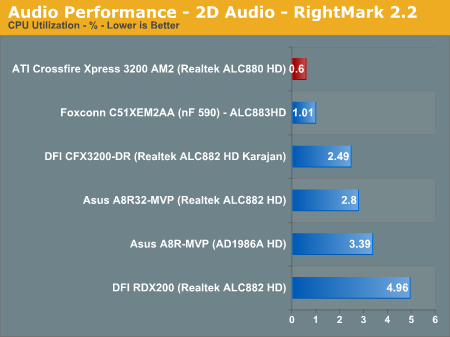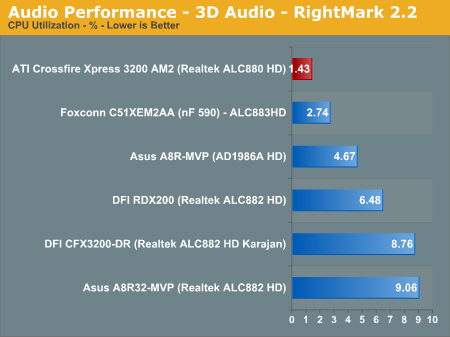CrossFire Xpress 3200: RD580 for AM2
by Wesley Fink on June 1, 2006 12:05 AM EST- Posted in
- Motherboards
Audio Performance
Audio testing used the latest version 2.2 of the Rightmark 3D Sound CPU utilization test. This benchmark measures the overhead or CPU utilization required by a codec or hardware audio chip. Versions earlier than 2.2 would not work properly on the RD580 chipset .



All benchmarks used Realtek Driver Version 1.36. CPU utilization across the board were the lowest we have ever measured with this utility, ranging from around 0.6% in Empty CPU and 2D tests to 1.4% in 3D and 3D+EAX tests. These utilization numbers are the result of the dual-core CPU as Realtek uses load sharing to drive the audio codec. Unfortunately, as we first described in Intel Core Duo: AOpen i975Xa-YDG to the Rescue, these low test results do not consistently translate into better FPS results in gaming. Results with HD audio on dual-core showed a similar loss of FPS whether run with a single or dual-core CPU.
Realtek has been very consistent in recent months in releasing regular updates to their HD audio drivers, and we suspect that trend will continue with ATI, Intel, and NVIDIA all now firmly committed to HD Azalia audio. Each new Realtek update has lowered CPU utilization and we also hope that will continue.
Audio testing used the latest version 2.2 of the Rightmark 3D Sound CPU utilization test. This benchmark measures the overhead or CPU utilization required by a codec or hardware audio chip. Versions earlier than 2.2 would not work properly on the RD580 chipset .



All benchmarks used Realtek Driver Version 1.36. CPU utilization across the board were the lowest we have ever measured with this utility, ranging from around 0.6% in Empty CPU and 2D tests to 1.4% in 3D and 3D+EAX tests. These utilization numbers are the result of the dual-core CPU as Realtek uses load sharing to drive the audio codec. Unfortunately, as we first described in Intel Core Duo: AOpen i975Xa-YDG to the Rescue, these low test results do not consistently translate into better FPS results in gaming. Results with HD audio on dual-core showed a similar loss of FPS whether run with a single or dual-core CPU.
Realtek has been very consistent in recent months in releasing regular updates to their HD audio drivers, and we suspect that trend will continue with ATI, Intel, and NVIDIA all now firmly committed to HD Azalia audio. Each new Realtek update has lowered CPU utilization and we also hope that will continue.










71 Comments
View All Comments
Wesley Fink - Thursday, June 1, 2006 - link
1X Increments corrected.We did not have audio performance data for nVidia chipsets in the 590 launch review, but it will be included in our roundup of 6 AM2 boards which is in process. I have added numbers for the Foxconn ( nForce 590) HD codec for reference. Foxconn is the nVidia Reference board.
The board photo was captured at 12 Megapixels. Unfortunately, the "Save for Web" feature in Photoshop which gets the image to a reasonable file size for posting a 1280 image compromises sharpness at higher resolutions.
Trisped - Thursday, June 1, 2006 - link
Thanks for the Foxconn numbers.So you used "Save for Web" and lowered the quality so it would be easier to download? That makes sense. A 43k file is much better then a 1M one.
JarredWalton - Thursday, June 1, 2006 - link
Or 422K vs. 5+ MB. ;)lopri - Thursday, June 1, 2006 - link
I truly appreciate AT staff's responses to my questions. It cleared so many things that I questioned while reading the review, so now I'm understanding better.This is actually the only possible explanation that I could think of. You're right in that DDR400 is the fastest JEDEC approved speed. I sort of guessed but still, considering the ammount of memory reviews you've done in the past, thought a bit stranage. But thank you for explaining. Request, however: Please do a out-of-the spec DDR vs DDR2 reviews in the future. :D This can be a big factor for people who actually consider upgrading.
Again, I appreciate the explanation. Not knowing about DDR2 much myself still, I could not have known it when reading the review. It'd have cleared up some misunderstanding if you have mentioned the 1T/2T issues in the review (like above), it'd have helped a ton to understand. I'm sure there are many different traits of DDR2 compared to DDR, without such knowledge I could not help but questioning. Thank you, Gary.
Still the 1T/2T issue on AM2 is somewhat disappointing. (Not reviewers' fault) I have a bad feeling that AMD's IMC won't be able to handle 1T for DIMMs faster than DDR2-800, even with future revision. :( For entire lifespan of Socket 939, they couldn't get 4 sticks to run @1T timing.. (except a couple going-around of DFI's)
lopri - Thursday, June 1, 2006 - link
Also if this is true, it's an absolutely fantastic news. Please let us know the detail as soon as you can. Thank you.
DigitalFreak - Thursday, June 1, 2006 - link
Maybe they didn't need to develop a new North bridge, but the South bridge is another matter. With ULi supplies drying up, it would have been extremely stupid to use the SB450 yet again.
Myrandex - Thursday, June 1, 2006 - link
It was stated that the ATI solution was better tahn the ULI and less than Nvidia, however in the graphs it was less than both, although very close to ULI.Jason
Wesley Fink - Thursday, June 1, 2006 - link
The statement is correct. Going back to review notes there was a typo in the chart creation which has now been corrected. USB throughput for SB600 is 241.6 and not 231.6 as shown in the earlier chart.Alyster - Thursday, June 1, 2006 - link
I just wonder if SB600 will be available on 939 boards in future. I'm going to purchase ATI based MSI-RS482M4-ILD mATX motherboard with SB450 and may be I should wait untill they start offering SB600 on mATX boards. Any suggestions? ThanksWesley Fink - Thursday, June 1, 2006 - link
As we understand it, SB600 is not pin-compatible with SB450, so it is not a drop-in for the older chip. We therefore think it is unlikely you should wait for a board redesign on an older 939 board. Any new 939 boards - and there may be some if the market wants them - will likely use SB600.